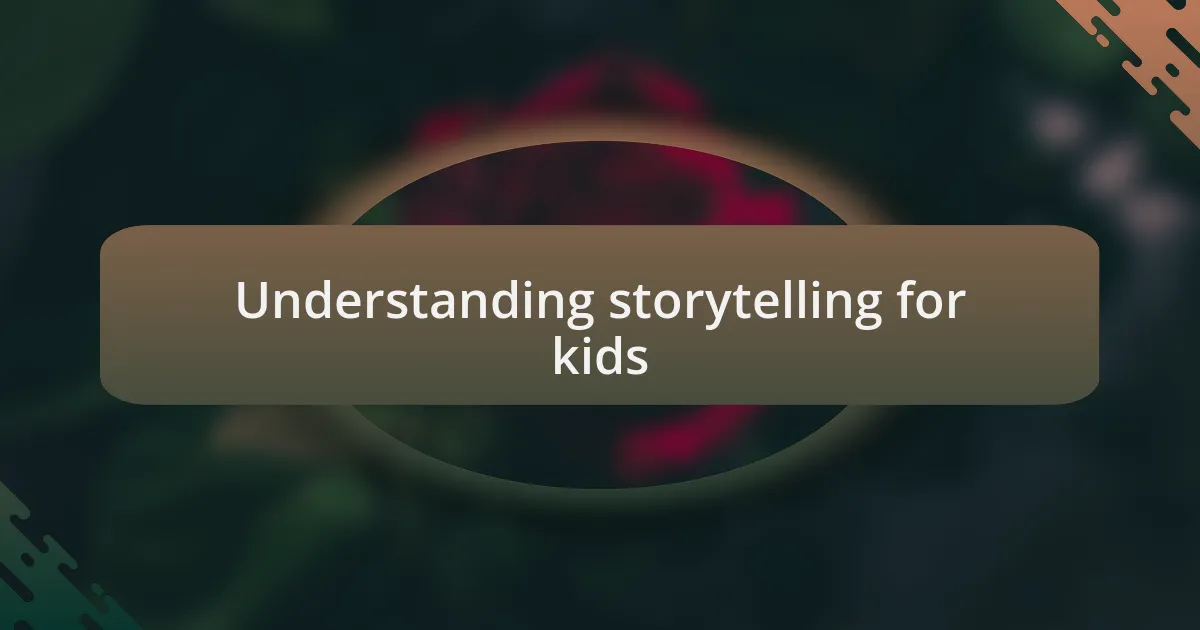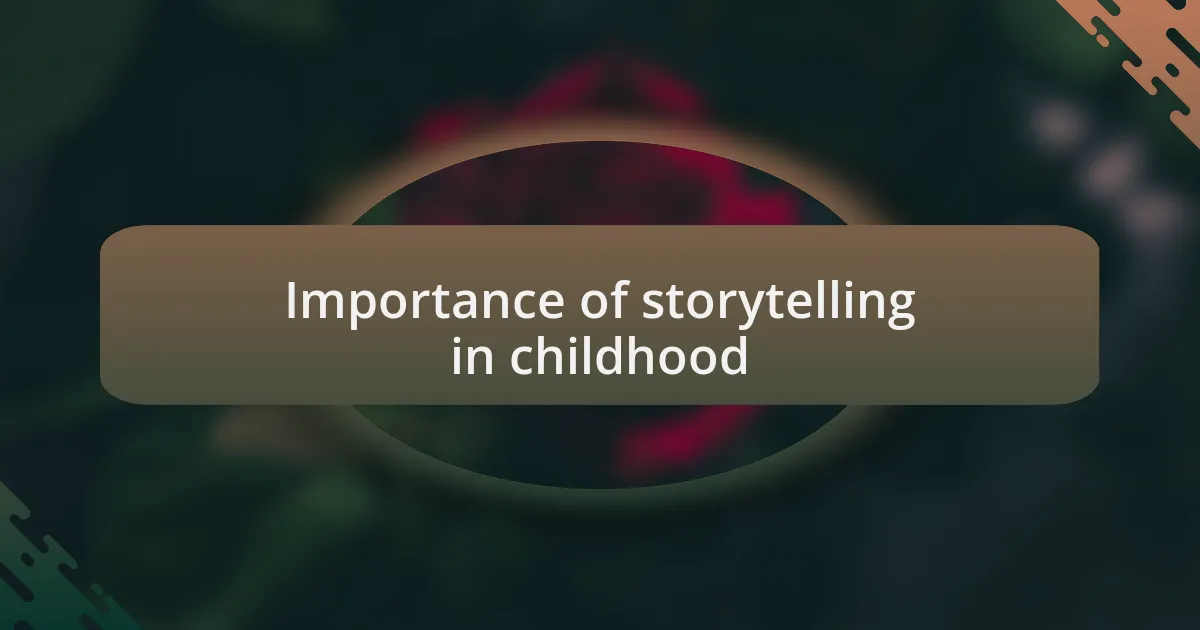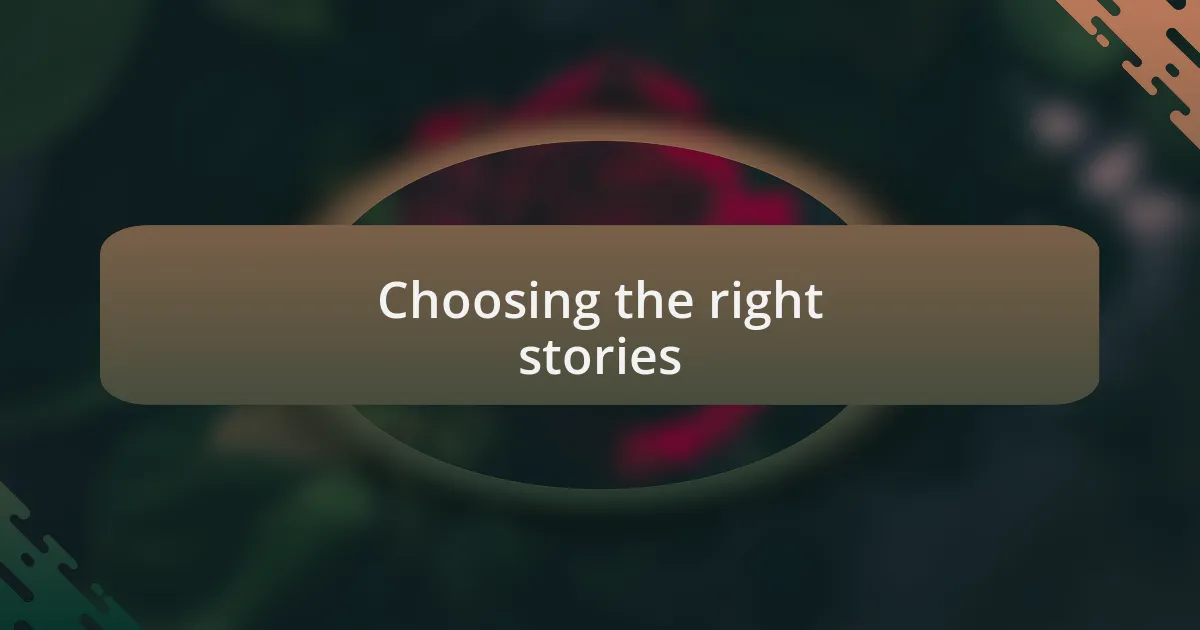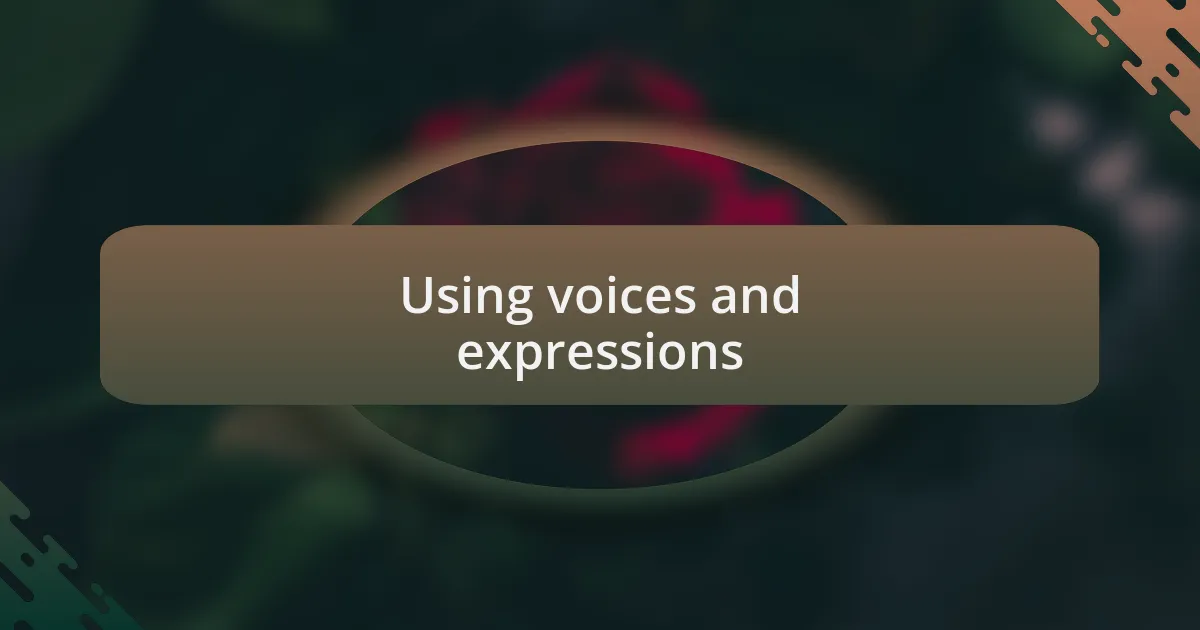Key takeaways:
- Storytelling ignites children’s imagination, fosters emotional exploration, and encourages critical thinking through relatable narratives.
- Interactive elements such as props, dialogue participation, and diverse storytelling formats enhance engagement and make stories more impactful.
- Choosing age-appropriate and culturally relevant stories deepens connections and broadens children’s understanding of different experiences.
- Utilizing varied voices, expressions, and humor creates an immersive storytelling experience that resonates with children on emotional levels.

Understanding storytelling for kids
Storytelling for kids is more than just sharing tales; it’s about sparking their imaginations and connecting with them emotionally. When I tell stories, I often watch their eyes light up, as if they’re stepping into a new world. Have you noticed how a simple story can inspire curiosity?
One approach that resonates well is to weave personal experiences into the narrative. I once shared a story about a time I felt brave, and my children were captivated. They eagerly asked if they’d ever feel the same courage. This interaction highlights how storytelling allows kids to explore their emotions and relate to experiences beyond their own.
Many children connect deeply with themes of adventure and friendship. Last week, I narrated a story about teamwork among animals in a forest. The kids chimed in, debating which animal was the best leader. This illustrated how storytelling not only entertains but also encourages critical thinking and collaboration, as kids translate these lessons into their own lives.

Importance of storytelling in childhood
Storytelling plays a crucial role in childhood development, fostering imagination and creativity. I remember a day when I told a story about a little girl who traveled to the stars. The enthusiasm in the room was palpable as the children envisioned their own space adventures. Isn’t it fascinating how their minds can create entire universes from just words?
Moreover, stories serve as a bridge for children to understand complex emotions. I once narrated a tale about loss and finding joy again. Afterward, one child opened up about losing a pet, sharing their feelings of sadness. This moment truly showcased the power of storytelling to validate feelings and instill emotional intelligence, don’t you think?
Additionally, storytelling strengthens language skills in young learners. When I incorporate rhymes and vivid descriptions, I often see kids practicing pronunciation and expanding their vocabulary. It’s incredible how eager they are to repeat phrases from the stories, transforming learning into a fun game. How wonderful is it to see education come alive through a captivating narrative?

Techniques for engaging kids
One effective technique I use to engage kids is incorporating interactive elements into the storytelling process. For instance, I often invite children to act out parts of the story. I remember a session where the kids became characters in a pirate adventure, complete with treasure maps and wooden swords. Their laughter and excitement were contagious, transforming a simple tale into a vivid experience—how can you not smile when kids are fully immersed like that?
Another method that has consistently worked for me involves asking open-ended questions throughout the story. During a story about a brave knight, I paused to ask, “What do you think he’s feeling right now?” This sparked a lively discussion where kids shared their thoughts and feelings, and I noticed that some were even able to connect it to their own lives. It’s moments like these that highlight how storytelling can serve as a springboard for deeper conversations and connections among children.
Finally, utilizing diverse storytelling formats, such as puppets or digital media, engages kids in different ways. I introduced a story using hand puppets one time, and suddenly, each child had their favorite character. Their reactions were spontaneous and genuine; they laughed and gasped in all the right places. Isn’t it amazing how a simple shift in presentation can capture their attention and stimulate their imagination so profoundly?

Choosing the right stories
When it comes to choosing the right stories, I always consider the interests and experiences of the kids in the audience. For example, I once told a tale about a lost puppy, and instantly, a few children mentioned their own pets. Their eyes lit up as they shared stories about their furry friends. Connecting the story to their personal experiences not only engaged them but also made the narrative resonate on a deeper level. How incredible is it that a simple story can lead kids to reflect on their own lives?
I’ve also found that age-appropriate themes play a crucial role in capturing kids’ attention. During a storytelling session for younger children, I opted for a fun, colorful adventure with lovable animal characters. They giggled and squealed at every twist and turn, while the older kids preferred tales with more complex characters and moral dilemmas. This experience reinforced my belief that stories must align not just with the developmental stage of the kids, but also with their emotional readiness to explore different themes. Isn’t it fascinating how the right story can unlock a treasure trove of imagination and learning?
Another factor I consider is the cultural relevance of the stories. I remember once sharing a folktale from a different culture. The kids’ curiosity was palpable; they asked insightful questions about the characters and customs. It sparked discussions that broadened their understanding of diversity. Choosing stories that reflect varied cultures not only enriches their storytelling experience, but also fosters empathy and connection. Who wouldn’t want to explore the world through the magic of stories?

Using voices and expressions
When I delve into storytelling, using different voices and expressions is a game changer. I remember a time when I mimicked a grumpy old wizard, and the kids burst into laughter. The transformation of my voice didn’t just make the character funny; it brought the entire scene to life, allowing the children to fully immerse themselves in the story. Have you ever noticed how a simple change in tone can capture attention instantly?
Expressions are equally vital; they convey emotions that words alone sometimes can’t. I often exaggerate my facial expressions, like widening my eyes in surprise or furrowing my brow in concern. One session, I played up a suspenseful moment, and suddenly, the kids were on the edge of their seats, anticipating what would happen next. Isn’t it amazing how our faces can communicate feelings so powerfully that children feel just as invested in the story as the characters are?
Combining voices and expressions creates a dynamic storytelling experience that resonates deeply. I make it a point to pause and allow tension to build, adding layers of excitement. During a particularly thrilling tale, I could feel the energy shift in the room: the kids leaned forward, captivated. They weren’t just listening; they were experiencing the adventure alongside me. How rewarding is it when storytelling transforms into a shared journey of imagination?

Interactive storytelling methods
Interactive storytelling methods can greatly enhance a child’s engagement with the narrative. One approach I’ve found particularly effective is incorporating props. During a story about a magical forest, I pulled out a stuffed animal and passed it around. It was fascinating to see the children’s imaginations ignite as they transformed the toy into a cherished character. Can you picture how it feels when kids become active participants rather than mere listeners?
Another interactive method involves inviting kids to participate in the dialogue. I often pause during key moments and encourage them to fill in the blanks or predict what happens next. Once, during a mystery story, I asked, “What do you think the detective will find at the next clue?” The excitement in their responses was palpable, and their involvement not only kept their attention but also made them feel like co-creators of the tale. Isn’t it incredible how their ideas can take the story in unexpected directions?
Lastly, I love using music and rhythm to engage the kids even more. I once introduced a fun sing-along element that matched the story’s pace. As we sang about characters embarking on a quest, the room filled with delightful energy, and I could see the kids investing themselves in the storyline. This method showed me firsthand how stories come alive when we invite children to participate fully. How satisfying is it to witness their joy and creativity unfolding right before your eyes?

Creating a personal storytelling style
Creating a personal storytelling style requires embracing what makes my voice unique. For instance, I often sprinkle my stories with regional dialects or phrases that resonate with my background. When I spoke about a friendly dragon from my hometown, using local expressions brought an authenticity that drew the children in deeper. Have you ever noticed how a familiar lingo can bridge a connection?
Additionally, reflecting my own experiences into the narrative can make it feel more relatable. I’ve shared stories about overcoming fears, like my childhood fear of thunderstorms, and recalled those feelings vividly while weaving in my character’s similar struggles. The children connected with that vulnerability, seeing parts of themselves in the tales I told. Isn’t it remarkable how our shared emotions can create such powerful bonds?
Finally, I believe that infusing humor into storytelling adds a delightful layer to the experience. While narrating a comical mishap in my life about a runaway puppy, I used exaggerated expressions and silly voices. The laughter that erupted from the kids was infectious, and I learned how humor fosters a relaxed atmosphere. Don’t you find it intriguing how laughter can serve as a glue that holds us together while we explore stories?